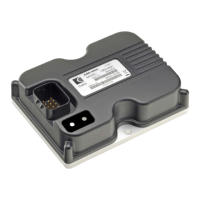Curtis 1352 eXm Manual, R ev. D
12
2 — INSTALLATION & WIRING: I/O Signal Specications
as the external resistance to ground will provide a divider with the internal pull-
up. The pull-up is 10 kΩ to ≈ 4.4 volts. The pull-up is turned on by setting the
correct bit in the Analog Source Enable parameter. The eXm will send back a
reading of the external resistance in ohms. The maximum resistance that can
be measured is 6.5 kΩ. An open pin will read 65535 (FFFFh).
These analog inputs can also be used simultaneously as virtual digital
inputs. These virtual digital inputs are created by comparing the filtered ana-
log signal to the the High and Low Threshold parameters. These parameters
also provide hysteresis. Once the signal goes above the High Threshold and is
sensed as On, it must pass below the Low Threshold to be be considered Off;
simply going below the High Threshold is not enough. The same is true for
a Low to High transition. Note that the thresholds are always set in voltage;
therefore if the Analog Source Enable (pull-up) is set to On for any channel,
the thresholds must be below 4.4 V in order to be active.
Power
The power pins are each capable of carrying up to 9A when using 16 AWG wire.
Every application must use B+ (pin 3) and at least one of the B– connections
(pins 1 and 2).
Since the eXm’s six drivers can sink a maximum combined load of 18 A,
you will need to determine the application’s maximum total loading on B–. To
prevent the pin from overheating, the proper wire gauge must be used* and, if
the load is greater than 9 amps, both B– pin connections are required.
If it is determined that both B– pins are required, you must also deter-
mine the load on B+. This requires either knowledge of the expected PWM or
actual in-application measurements. The combined average current recirculating
through the B+ pin cannot exceed 9 amps. This can be an issue if the inductive
loads are specified at a lower voltage than the battery supply as the applied
PWM would normally be reduced to not exceed the average applied voltage or
current. The lower PWM in turn raises the average current flowing through the
B+ pin as the load current recirculates for a great portion of the PWM period.
* 18 AWG is limited to 7.3 Amps. 20 AWG is limited to 6.6 Amps.
Communications lines
Pins 4 and 5 provide the CAN connections.
CAN SIGNAL SPECIFICATIONS
supported
protected esd
signal name pin protocol/devices
data rate voltage range tolerance
CANH 5 CANopen up to 1 Mbps Continuous= ± 8 kV (air
CANL 4 - 36 V to discharge)
(MaxV + 10 V)
Transient=
± 200 V
51
1410
6 9
51
1410
6 9

